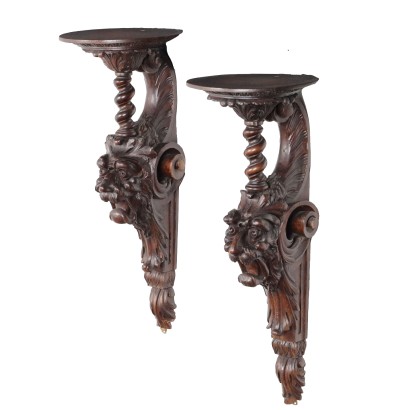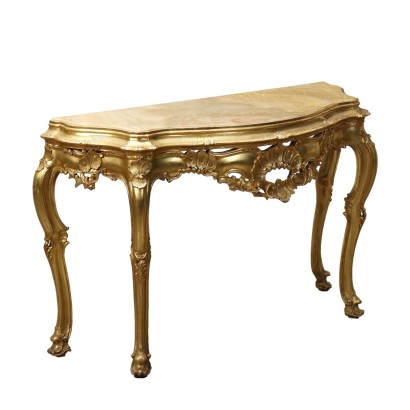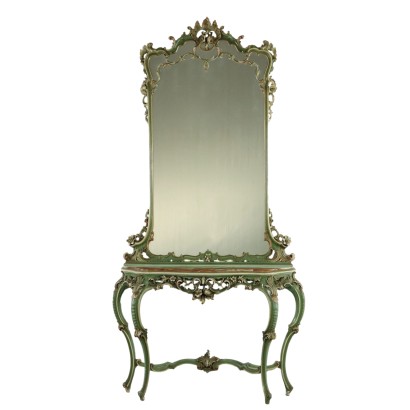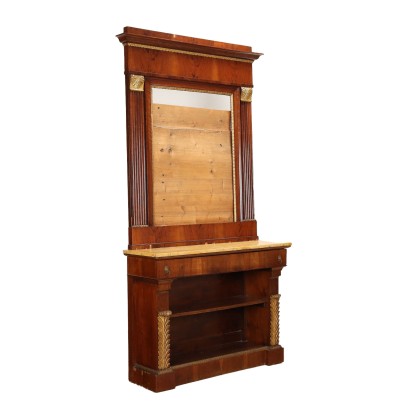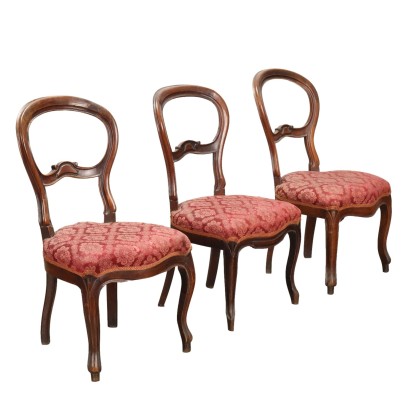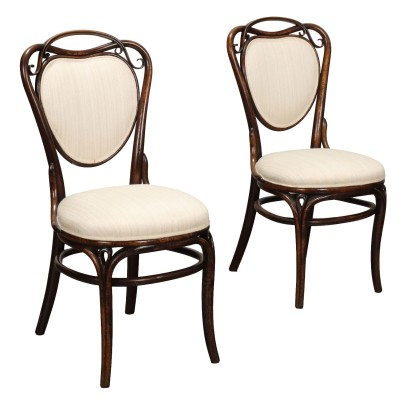Pair of Antique Neo-Baroque Shelves Italy Late XIX Century - Italy, Late XIX Century
Features
Italy, Late XIX Century
Style: Neo-Baroque (1860-1890)
Age: 19th Century / 1801 - 1900
Origin: Italy
Main essence: Mahogany
Description
Pair of carved mahogany shelves with large masks supporting twisted columns on which the top stands. Italy 19th century
Product Condition:
Product which due to age and wear requires restoration and re-polishing. We try to present the real state of the furniture as completely as possible with photos. If some details are not clear from the photos, what is stated in the description applies.
Dimensions (cm):
Height: 66
Width: 25
Depth: 25
Additional Information
Style: Neo-Baroque (1860-1890)
Anticipated in England in the first half of the 19th century on the reminiscences of the Elizabethan style, it came back into fashion around 1870, but interpreted in a very free way.It initially represents a response to the frivolity of neo-Rococo, but soon lapses into a pompous and eclectic style that combines severe sixteenth-century elements with sculptural decorations from the early 17th century.
The furniture is solid, richly carved and carved, in dark patina wood.
Garnets, frames, columns carved with herms that make up architectural structures typical of Renaissance palaces, are the elements that characterize the neo-Renaissance style.
It was an era in which we saw the revival and re-proposal of ancient forms with a typically Renaissance taste, large carvings were used for a more complete, deeper and three-dimensional vision, the use of animal paws in chests and wardrobes, squares and moldings, frames, bossages and claws, Romanesque ornamental motifs but also acanthus leaves, cartouches and lion heads.
Often in this period, furniture was built using ancient materials and parts of Renaissance furniture.
Walnut was often used but also less hard essences such as poplar or others since they were often darkened and presented in black.
Find out more with the insights of our blog:
The Neobaroque in a large 19th century table
INSERT ADDITIONAL LINKS
Austrian taste for Baroque
Rococo style in Italy
The Renaissance and its impact on design
Age: 19th Century / 1801 - 1900
19th Century / 1801 - 1900Main essence: Mahogany
It is one of the most precious and sought-after woods in cabinet making. It was discovered in Central America around 1600 and began to be imported to England in the 1700s. Much appreciated for its hardness and indestructibility, it became widespread following the blocking of walnut exports from France in 1720 and the consequent elimination of English import duties on mahogany from the colonies in America and India. The most valuable version comes from Cuba, but it became very expensive. At the end of the 18th century it began to be used also in France in Louis XVI, Directory and Empire furniture, its diffusion declined starting from when Napoleon, in 1810, forbade its import. It was generally used in the manufacture of elegant furniture, due to its characteristics and beautiful grain.Other customers have searched:
Approfondimenti
Scopri di più sulle consolle e tavoli parietali con gli approfondimenti del nostro blog e di FineArt:Una superba consolle austriaca
L'attenzione neoclassica per i dettagli in una consolle torinese decorata a pastiglia
Una raffinata consolle demi-lune piemontese neoclassica
L'estetica elegante e raffinata di una Consolle fratinata
Simili ma diverse: una consolle Luigi Filippo e una umbertina a confronto
Consolle a pastiglia
Tavolo parietale, Firenze 1780-1785ca.
Consolle inglese, metà XIX secolo
Consolle parietale
Coppia di consolle in pietre laviche
Consolle anni '50, manifattura italiana
Sull'antiquariato in generale dai un'occhiata anche a
Classic Monday: da un pezzo dei nostri magazzini alla storia dell'antiquariato
Il dizionario dell'antiquariato - Lastronatura
Il dizionario dell'antiquariato - Mascherone
Il dizionario dell'antiquariato - Natura morta
Il dizionario dell'antiquariato - Opificio
Il dizionario dell'antiquariato - Pastiglia
Il dizionario dell'antiquariato - Savonarola
Il dizionario dell'antiquariato - Rosone
Product availability
The product can be seen at Cambiago
Immediate availability
Ready for delivery within 2 working days from ordering the product.



